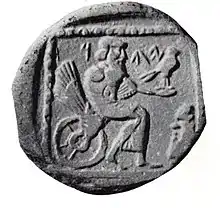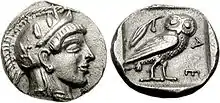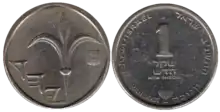The Yehud coinage is a series of small silver coins bearing the Aramaic inscription Yehud.[2] They derive their name from the inscription YHD (𐤉𐤄𐤃), "Yehud", the Aramaic name of the Achaemenid Persian province of Yehud; others are inscribed YHDH, the same name in Hebrew. The minting of Yehud coins commenced around the middle of the fourth century BC (ca 350 BC), and continued until the end of the Ptolemaic period.[3]
Date and origin
In 2023, numismatic scholars Gitler, Lorber, and Fontanille have published an updated classification and chronology of the Yehud coinage. It is now seen as comprising 44 types of coins. The series began with a small number of drachms with Aramaic legends, classified as Types 1–3, which were produced at a mint at some location in Philistia. The scholars believe that this mint was executing a commission from the provincial administration of Judah.[4]
It is only with the next issue of coins, Type 4 (the Series with Athena), that the minting began in Judah.[5] These coins feature a Paleo-Hebrew legend, as opposed to the earlier issues with an Aramaic legend.
These conclusions were reached based on the comparison of Yehud coins with the earlier coins of Philistia, but especially with the coins of Samaria, which were much more numerous and earlier than those of Judea.[6]
This opening of a mint in Judah seems to have been marked by the beginning of the production of much smaller coins, that are rather unusual in the general regional context of the Eastern Mediterranean. Afer this, the production of these fractional coins by the Yehud mint continued for a considerable period of time. The scholars believe that perhaps these smaller coins were more suitable for the generally agrarian economy of this province.[7] But it is also possible that they were somehow associated with the Temple of Jerusalem, and the need for the smaller coin denominations as Temple payments.[8]
Seventeen types of Yehud coins were published in the Achaemenid Persian context. After the Macedonian conquest of Alexander the Great, the minting of these coins continued with the Type 18 coins.[9]
The Macedonian period Yehud coins comprise the Types 18 to 32. They feature many coins portraying animals such as lynx, owl and duck. They also carry images of mythological winged bull and winged horse.
The Ptolemaic coins minted in Judea are Types 33 to 44. They carry only the Yehud legend, and no Greek lettering. The minting of Yehud coins stopped after the Ptolemaic period. The next coin series was minted at the time of John Hyrcanus I with different legends.[10]
Notable coins
The Yehud coins of Hezekiah (governor), and a single coin of Johanan (High Priest) have attracted considerable attention. In regards to Hezekiah/Yehizqiyah, there are many such coins of several types with and without the title 'governor'. The more recent research indicates that, on the earlier coins, only the name of Hezekiah/Yehizqiyah is given. But then the title was added.[11]

The famous ‘British Museum drachm’, first published in 1814, had been much commented upon by the biblical and other scholars, and it is sometimes described as the earliest coin minted in Israel. It was even the subject of a special monograph, that nevertheless did not reach any firm conclusions.[12] The coin presents an image of a divinity seated on a winged wheel that was often interpreted as a representation of Yahweh, the God of Israel. The legend on the coin is somewhat unclear; it is interpreted as either "YHW" (Yahu) or "YHD" (Judea).[13] It has been classified as Type 2 Yehud coin.[14]
The obverse of this coin also features the portrait of a man in a military helmet that many interpreted as Bagoas, a general of Artaxerxes III.[15]
According to a detailed study by Shenkar (2008), an attribution of this coin to a Samarian mint is plausible, based on its "weight, chemical composition and iconography". So it could be a "unique attempt to depict a Samarian Yahweh". Only one such coin is known, and it may have been designed to combine "the most powerful and widely known images of deities – Zeus and Ahuramazda to produce something eclectic and new."[16]
Earlier research
In the past, Mildenburg dated Yehud coins from the early 4th century BCE to the reign of Ptolemy I (312–285 BCE), while Meshorer believed there was a gap during Ptolemy I's time and that minting resumed during Ptolemy II and continued into Ptolemy III, although this has been questioned.[2]
The YHD coins were generally believed to date from the Persian period, but some of the YHDH coins were also seen as being from the following Ptolemaic period.[2]
The earlier coins were believed to have been produced in imitation of Athenian coins. But the more recent research has stressed the importance of the influence from the Phoenician and Samaritan area. Ultimately the numismatic trends were nevertheless traced to the area of Tarsos and Cilicia (satrapy) in the coastal Asia Minor, which was the economically flourishing cosmopolitan area at the time, after the conquest of Cyrus the Great.[17]
Yehud coins were used locally as a small change to facilitate local economy. Nevertheless, the larger denomination coins from more centralized mints elsewhere in the region were also circulating in large numbers, especially in the context of foreign trade.[18]
The use of figural art
Unlike later Jewish coinage, Yehud coins depict living creatures, flowers and even human beings.[19]
During the First Temple period, figural art was frequently used, centralized cherubim over the Ark of the Covenant, the twelve oxen that supported the giant laver in front of Solomon's Temple, etc. Thus, it is likely that the Yehud coins are continuing the use of figural art from the previous period. The traditional religious prohibition against graven images was probably seen as relating only to idolatrous images rather than the purely decorative.
Depictions on the coinage include imagery borrowed from other cultures, such as the Athenian Owl, and various mythological creatures. The lily flower was also commonly portrayed.[20]
Various human images are also portrayed. Some coins bear images of Persian rulers. The identity of other human images are not always clear; some of them may even be images of Jewish leaders, such as Temple priests.[21]
One coin depicts an enthroned deity, claimed by some experts to be Yahweh, while this is disputed by others.[22] It has been suggested recently that this coin was actually minted in Samaria and depicts Samarian Yahweh.[23]
Coin features and chronology

The coins from the Persian period tend to be inscribed in Aramaic "square script" or Paleo-Hebrew and use the Aramaic spelling of the province as 'y-h-d', while those coins from the Ptolemaic/Hellenistic period (or maybe earlier) are inscribed in the Paleo-Hebrew script and usually spell Judea as 'y-h-d', 'y-h-d-h' or 'y-h-w-d-h'.[24]
A 2009 study by Yehoshua Zlotnik attempts to relate different kinds of coins, and the specifics of their manufacture to the changing political situation in Judea in the 4th century BCE. He deals with different coin-types, and with such unusual phenomena as minting on only one side of the coin, and seemingly deliberate flaws on certain dies. According to Zlotnik, these and other features can clarify the political state of affairs in Judah, such as independence, autonomy, or transition period.[25] However, Zlotnik's comparisons of Yehud coins with contemporary coins from various neighbouring mints, such as Samaria, Edom and Sidon are quite limited, and do not consider the influence from the Achaemenid empire.

According to Zlotnik, the first minting of “Yehud” coins began under the influence of the contemporary Egyptian revolts against Persia.[26] However this link with the revolts has not been clarified. Before the Ptolemaic dynasty introduced standard coinage to Egypt, pre-existing native dynasties made only very limited use of coins. Egyptian gold stater was the first coin ever minted in ancient Egypt around 360 BC during the reign of pharaoh Teos of the 30th Dynasty. But these were gold coins that were mostly used to pay salaries of Greek mercenaries in his service. The small silver coins (obols) of Yehud type were not common in Egypt at that time.
The Persian reconquered the area after 360 BCE, so this is the likely beginning of the Yehud mintage. This type of minting continued also under the Ptolemies.[26]
Mildenberg divided most of the Persian period 'Yehud' coinage into three groups: an early group of poorly defined coins with the head of Athena on the obverse with her owl on the reverse with the inscription 'y-h-d' in Paleo-Hebrew; the second group are more clearly defined and depict a lily, and an Egyptian falcon (see pictures), and the head of the Persian king, with the inscription 'y-h-d'; the third group has the Hebrew inscription 'Hezekiah the governor' (yḥzqyh hpḥh). Yet the more recent research indicates that on the earlier coins, only the name of Hezekiah/Yehizqiyah is given without the title.
Almost all of these coins have been found in the area of Judea.[27]
The minting of Yehud coins stopped after the Ptolemaic period.
Coin metrology
In older research, the Yehud coins were seen to come in two denominations, approximately .58 gram as a ma'ah and approximately .29 gram as a half ma'ah (chatzi ma'ah).
More recently, Y. Ronen conducted a groundbreaking metrological study of Yehud coins.[28]
- "He calculated the average (modal) weights of five different varieties of Yehud coins and found that some conform to the gerah and half gerah of the Persic weight standard (divisions of the shekel or Persic stater of c. 11.4 g, weighing 0.48 g and 0.255 g, respectively), while others conform to the hemiobol and quarter obol of the Attic weight standard (0.315 g and 0.195 g, respectively)."[29]
For the larger transactions, many bigger coins were used at the time, such as the Philistian and Phoenician coins that were mostly influenced by the Athenian drachma and the tetradrachm. Also the Persian coinage, the Persian daric and the Sigloi were used, and later the Ptolemaic coinage. As the evidence from the discovered coin hoards has shown, in these hoards, the Yehud coins usually were only a very small part of the hoard.[30]
Heritage

The lily symbol with the legend 𐤉𐤄𐤃 (YHD) appears on the obverse of the one Israeli new shekel coin (שקל חדש אחד).
See also
- Iudaea Province, the Roman province of Judaea (6–135 CE)
- Yehud Medinata ("Province of Judah"), Persian province (6th-4th c. BCE)
- List of historical currencies
- ma'ah, Aramaic for gerah, ancient Hebrew unit of weight and currency
- Hasmonean coinage
- Shekel, ancient Near Eastern unit of weight and coin
- Zuz, ancient Jewish name for certain silver coinage
References
- ↑ Gerson, Stephen. "Fractional Coins of Judea and Samaria in the Fourth Century BCE". Near Eastern Archaeology. 64 (3). doi:10.2307/3210840.
- 1 2 3 Rooke, Deborah W. (March 9, 2000). Zadok's Heirs:The Role and Development of the High Priesthood in Ancient Israel: The Role and Development of the High Priesthood in Ancient Israel. Clarendon Press. ISBN 978-0-19-826998-4 – via Google Books.
- ↑ Gitler H., Lorber C., Fontanille J.-P. (2023), The Yehud Coinage: A Study and Die Classification of the Provincial Silver Coinage of Judah. (Introduction) Israel Numismatic Society; Jerusalem, Israel.
- ↑ Gitler H., Lorber C., Fontanille J.-P. (2023), The Yehud Coinage: A Study and Die Classification of the Provincial Silver Coinage of Judah. (Introduction) Israel Numismatic Society; Jerusalem, Israel.
- ↑ The Menorah Coin Project website. Israel Numismatic Society. See YHD-04 (Type 4)
- ↑ Wyssmann, Patrick 2014, The Coinage Imagery of Samaria and Judah in the Late Persian Period. in A "Religious Revolution" in Yehud? The Material Culture of the Persian Period as a Test Case. Christian Frevel, Katharina Pyschny and Izak Cornelius (eds.), 221-266. Göttingen: Academic Press, 2014.
- ↑ Gitler H., Lorber C., Fontanille J.-P. (2023), The Yehud Coinage: A Study and Die Classification of the Provincial Silver Coinage of Judah. (Introduction) Israel Numismatic Society; Jerusalem, Israel.
- ↑ Wyssmann, Patrick 2014, The Coinage Imagery of Samaria and Judah in the Late Persian Period. in A "Religious Revolution" in Yehud? The Material Culture of the Persian Period as a Test Case. Christian Frevel, Katharina Pyschny and Izak Cornelius (eds.), 221-266. Göttingen: Academic Press, 2014. p.255
- ↑ YHD 18: Hemiobol with helmeted head/lynx to left. The Menorah Coin Project website. Israel Numismatic Society.
- ↑ The Menorah Coin Project website. Israel Numismatic Society. See Section 3. "Ptolemaic period" and later
- ↑ Haim Gitler, Catharine Lorber 2008, A new chronology for the Yehizkiyah coins of Judah. Schweizerische Numismatische Rundschau 87, 2008, S. 61–82
- ↑ Michael Shenkar 2008, The Coin of the ‘God on the Winged Wheel’. Boreas 30/31 (2007/2008), pp. 13–23
- ↑ See the Description at commons.wikimedia.org
- ↑ YHD 02: Drachm with helmeted male portrait The Menorah Coin Project website. Israel Numismatic Society
- ↑ ¼ Shekel Judea numista.com
- ↑ Michael Shenkar 2008, The Coin of the ‘God on the Winged Wheel’. Boreas 30/31 (2007/2008), pp. 13–23
- ↑ Wyssmann, Patrick 2014, The Coinage Imagery of Samaria and Judah in the Late Persian Period. in A "Religious Revolution" in Yehud? The Material Culture of the Persian Period as a Test Case. Christian Frevel, Katharina Pyschny and Izak Cornelius (eds.), 221-266. Göttingen: Academic Press, 2014.
- ↑ Rooke, Deborah W., "Zadok's heirs: the role and development of the High Priesthood in ancient Israel", Clarendon Press, Oxford, 2000, pp. 225–6
- ↑ The Menorah Coin Project website. Israel Numismatic Society. See 'Patriotic series' and others
- ↑ The Menorah Coin Project website. Israel Numismatic Society
- ↑ Lee I. Levine, Jerusalem: Portrait of the City in the Second Temple Period (538 B.C.E. – 70 C.E.). Jewish Publication Society, 2002 ISBN 0827607504
- ↑ Eerdmans Dictionary of the Bible by David Noel Freedman, Allen C. Myers, Astrid B. Beck Published by Wm. B. Eerdmans Publishing, 2000 ISBN 0-8028-2400-5, pg 914
- ↑ Shenkar, M. “The Coin of the ‘God on the Winged Wheel’”, BOREAS. Münstersche Beiträge zur Archäologie 30/31, 2009, pp. 13–23
- ↑ The Emergence of Yehud in the Persian Period: A Social and Demographic Study by Charles E. Carter Published by Continuum International Publishing Group, 1999 ISBN 1-84127-012-1, pg269
- ↑ Yehoshua Zlotnik (2009), Coin minting in Eretz Israel during the Persian period – does it reflect various political situations? The Open University of Israel, Department of History, Philosophy and Judaic Studies
- 1 2 Yehoshua Zlotnik (2012), Minting of coins in Jerusalem during the Persian and Hellenistic periods.
- ↑ A History of the Jews and Judaism in the Second Temple Period: Yehud, the Persian Province of Judah by Lester L. Grabbe Published by Continuum International Publishing Group, 2004 ISBN 0-567-08998-3, pg 65
- ↑ Y. Ronen, Some Observations on the Coinage of Yehud, INJ 15, 2003–6, pp. 28–31
- ↑ Haim Gitler, Catharine Lorber 2008, A new chronology for the Yehizkiyah coins of Judah. Schweizerische Numismatische Rundschau 87, 2008, S. 61–82
- ↑ Haim Gitler 2017, Circulation of Southern Palestinian Athenian-Styled Fractions after the Conquest of Alexander the Great. academia.edu
Further reading
- Nahman Avigad, Bullae and Seals from a Post-Exilic Judean Archive. Publication: "Qedem" – Monographs of the Institute of Archaeology, The Hebrew University of Jerusalem. Editor: Y. Yadin, 1976.

